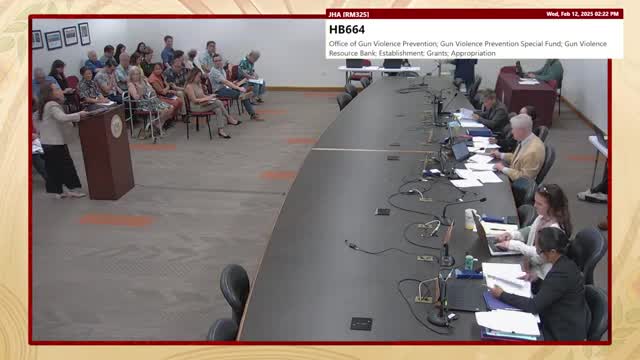Committee advances bill to create Office of Gun Violence Prevention, but AG recommends consolidating existing commission
February 08, 2025 | House Committee on Judiciary & Hawaiian Affairs, House of Representatives, Legislative , Hawaii
This article was created by AI summarizing key points discussed. AI makes mistakes, so for full details and context, please refer to the video of the full meeting. Please report any errors so we can fix them. Report an error »

The House Committee on Judiciary & Hawaiian Affairs advanced legislation on Feb. 12 to create a state Office of Gun Violence Prevention, a grant program and a gun violence resource bank. HB664 also would set up a Gun Violence Prevention Special Fund and appropriate money into it.
Attorney General Melina Sanchez testified with written comments that the bill should include standards for grant awards and noted overlapping responsibilities between the proposed office and the existing Gun Violence and Violent Crimes Commission codified under chapter 134C of the Hawaii Revised Statutes. The attorney general recommended either consolidating the commission’s responsibilities into the new office and repealing chapter 134C, or otherwise clarifying roles to avoid duplication.
Supporters told the committee the state needs a centralized hub to coordinate prevention, pull federal funding, and raise public awareness. Sarah Sumati of Everytown for Gun Safety said an office would allow Hawaii to approach gun violence “from every angle by serving as a centralized hub” for coordination, education and grantmaking. Erica Yamauchi of Everytown and Moms Demand Action pointed to the office’s potential to help the state draw down federal and philanthropic funds for community violence intervention.
Why it matters: Testimony emphasized both public-health and fiscal angles — advocates said a funded office could better coordinate interventions and access federal grant opportunities; the attorney general emphasized statutory and administrative issues, noting overlapping duties with an existing commission.
Committee action and next steps: The committee advanced HB664 with technical changes and added language (including draft grant standards suggested by the attorney general) but did not adopt the AG’s proposal to consolidate the existing commission due to drafting and title concerns. The measure will proceed to Finance for appropriations and further refinement of the statutory structure.
Ending: The committee’s action keeps open a path toward a single statewide entity focused on prevention and coordination while leaving unresolved how the new office would interact with or absorb duties of the existing statutory commission.
Attorney General Melina Sanchez testified with written comments that the bill should include standards for grant awards and noted overlapping responsibilities between the proposed office and the existing Gun Violence and Violent Crimes Commission codified under chapter 134C of the Hawaii Revised Statutes. The attorney general recommended either consolidating the commission’s responsibilities into the new office and repealing chapter 134C, or otherwise clarifying roles to avoid duplication.
Supporters told the committee the state needs a centralized hub to coordinate prevention, pull federal funding, and raise public awareness. Sarah Sumati of Everytown for Gun Safety said an office would allow Hawaii to approach gun violence “from every angle by serving as a centralized hub” for coordination, education and grantmaking. Erica Yamauchi of Everytown and Moms Demand Action pointed to the office’s potential to help the state draw down federal and philanthropic funds for community violence intervention.
Why it matters: Testimony emphasized both public-health and fiscal angles — advocates said a funded office could better coordinate interventions and access federal grant opportunities; the attorney general emphasized statutory and administrative issues, noting overlapping duties with an existing commission.
Committee action and next steps: The committee advanced HB664 with technical changes and added language (including draft grant standards suggested by the attorney general) but did not adopt the AG’s proposal to consolidate the existing commission due to drafting and title concerns. The measure will proceed to Finance for appropriations and further refinement of the statutory structure.
Ending: The committee’s action keeps open a path toward a single statewide entity focused on prevention and coordination while leaving unresolved how the new office would interact with or absorb duties of the existing statutory commission.
View full meeting
This article is based on a recent meeting—watch the full video and explore the complete transcript for deeper insights into the discussion.
View full meeting
